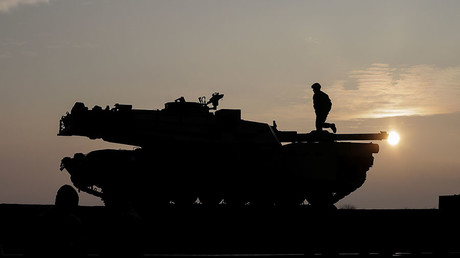Trump’s fastest way to Iran might be through Lebanon
Darius Shahtahmasebi is a New Zealand-based legal and political analyst, currently specializing in immigration, refugee and humanitarian law.
Published time: 13 Feb, 2019 16:13Edited time: 13 Feb, 2019 17:30

The US is keeping itself busy in the regime-change department during the first two months of 2019. While a lot of recent focus has been on Venezuela, the US still maintains a strong anti-Iran stance which cannot go unnoticed.
On December 26, 2018, the National Interest ran an article entitled“Navy Nightmare: Could Iran Sink a US Aircraft Carrier?” It is unclear if the editors of the magazine are suffering from amnesia, or are just worried that their earlier work had been ignored, but just over a week ago the outlet ran a separate article with a suspiciously similarly worded title: “Could Iran’s Missiles Do the Unthinkable: Sink a U.S. Navy Aircraft Carrier?”
Well, I’m not so sure. Perhaps if you ask the question enough times, it will almost certainly become true. Much like the way the US media repeats lies about Iraq, Syria, Venezuela and elsewhere until they become an acceptable part of public discourse, we should probably expect it to be no different when it comes to news pertaining to the so-called threat that Iran poses to the US military.
That being said, Iran did just release an animated video showing one of its latest submarines sinking a US Navy aircraft-carrier strike group albeit in a somewhat cartoonish depiction. As comedic as the video may appear, it pays to bear in mind that the US Navy recently said it had given up the development of a program which would defend aircraft carriers against torpedoes (but only after $760 million had been spent first).
Recently, Tehran also unveiled its latest missile, in the process displaying rare footage of a secretive underground complex where it is building its missiles. In spite of numerous threats from prominent US officials, Iran has remained adamant that it will continue the development of its missile program.
We all know deep down that the US will not take any potential threat from Iran lightly. During US President Donald Trump’s infamous State of the Union Address (SOTU), the president said loud and clear that his “administration has acted decisively to confront the world’s leading state sponsor of terror, the radical regime in Iran…To ensure this corrupt dictatorship never acquires nuclear weapons, I withdrew the United States from the disastrous Iran nuclear deal.”
Despite the ramblings of a senile billionaire reality TV show president, the January 2019 report compiled by the Director of National Intelligence admits that US intelligence officials “continue to assess that Iran is not currently undertaking the key nuclear weapons-development activities we judge necessary to produce a nuclear device.”
Statements like the ones in the SOTU address, or the ones found incessantly on the US president’s Twitter timeline, are a longstanding continuation of his animosity toward Tehran, and Trump’s appointments of dogmatic Iran-hawks John Bolton and Mike Pompeo last year further solidified Trump’s hatred of the Iranian government. Anyone who had been paying attention knew that Iran was on the horizon for the war machine, especially with Bolton’s backing of the MEK and his announcement that regime change in Iran would be celebrated by the end of last year. And, of course, we cannot forget Mike Pompeo’s scheduled summit for February which planned to initiate a new “pressure campaign” against Iran, which quickly fell apart when even its own allies expressed a lack of interest in attending a summit which was going to obsess over Iran (Russia said it would not attend at all).
Though, one should bear in mind that the US has had its sights on Iran since they lost control of the country in the Iranian revolution in 1979. Since then, the US used its then-puppet in Baghdad, Saddam Hussein to launch a bloody war of aggression against Iran during which Iran almost lost an entire generation of its citizenry. Since then, the US has relentlessly crippled the Iranian economy through sanctions, has surrounded the nation with its military bases and invaded several of its neighbors, all the while bringing the hammer down with constant threats of all-out war (even under the Obama administration).
The real question then becomes: if the US is sincere in its aim of bringing down the Iranian government and if Europe, Russia, and China are successful in helping Iran elude US-enforced economic sanctions, at which point will the US actually take its military to Tehran for a genuine confrontation?
While the US has threatened war with Iran for decades, even shooting down its civilian aircraft in the process and refusing to apologize for it, the truth is that the US has constantly looked for ways to bring down the Iranian government as an alternative to relying on brute force. A clear example of this is a leaked release from the Hillary Clinton archives which states that the “best way to help Israel deal with Iran’s growing nuclear capability is to help the people of Syria overthrow the regime of Bashar Assad.”
This was a nice and hopeful strategy for a while, but after Russia and Iran intervened in support of the Syrian government, the US has essentially found Syria to be a lost cause. Iran has more influence in Syria than it ever would have had if not for the overwhelmingly violent support for the Syrian opposition from the US, NATO countries and the Gulf States, and Russia more-or-less emerged from the rubble of the Syrian battle arena as a major power-broker in the region, leaving the US on the sidelines. Remember that the US is supposedly withdrawing its military from Syria around April this year, further cementing the idea that the US has basically lost any meaningful leverage it has in the war-torn country. (In Vietnam War 2.0 fashion, the American military made sure to make as much of Syriauninhabitable as possible before it voluntarily decided it was time to leave the country, though that is a topic for a separate article).
Barely a week ago, reports also emerged that US forces reneged on an order in 2017 to fire upon Iranian-backed troops traveling through south-eastern Syria as they believed the order was outside the scope of their rules of engagement. (The target of the purported strike was a port-a-potty; not the most ludicrous story you will read this year). In this context, it should be no surprise that the US has had to go back to the drawing board with regard to Iran.
The US may have lost a meaningful opportunity to confront Iran in Syria, but there is still one other major country in the region which it has not managed to raze to the ground just yet, which can potentially be another route to draw Iran into an open conflict or alternatively, remove (or attempt to remove) yet another key Iranian ally.
Just days ago, Iran’s foreign minister, Mohammad Javad Zarif, offered Iran’s support for the US-backed Lebanese military while speaking to reporters at Beirut’s airport not long after his arrival, having been met by Hezbollah lawmakers at his destination. His controversial comments followedHezbollah leader Hassan Nasrallah’s calls to ask Iran to supply Lebanon with weapons and aerial defense systems to take on Israeli warplanes.
Over the past few years, the US’s steadfast ally Israel has been actively preparing for a rematch with Hezbollah in Lebanon. In 2017, Israel hosted its largest military drill in 20 years, specifically designed to simulate a war with Hezbollah in neighboring Lebanon.
In March last year, Israel simulated a multi-front war in which Russia had intervened to protect Syria from Israeli attacks. Such a scenario could only come about as a result of Israel’s true intention to take on Hezbollah in Lebanon, according to the Israeli Defence Forces (IDF).
Just so we are clear: Israel practiced a full-on invasion of Lebanon, and then ran simulations to prepare for a scenario in which Russia – a nuclear power – had intervened in Syria to protect Syrian forces from Israeli aggression.
In February last year, thousands of US and Israeli troops took part in the biennial “Juniper Cobra” drill which also simulated a “massive ballistic missile attack against Israel”and in turn, the joint US-Israeli response. As far as we know, there is only one country likely capable of launching a massive ballistic missile attack against Israel, and that country is not Iran or Syria.
“According to Israeli intelligence,” Professor Noam Chomsky of MIT told me via email last year, “Hezbollah has lots of missiles based in many parts of Lebanon that are capable of serious damage to Israeli cities, and to take them all out would require quick virtual destruction of Lebanon, it seems.”
There are enough indications that if Israel goes to war in any of the arenas presented to it, that the US will support its endeavors to counter Iran militarily. If this is the case, then the US will almost certainly enough find itself in a disastrous war with Iran sooner or later, even if that war begins to open up in Beirut first.
While this isn’t highlighted as a story worthy of our attention, you can find multiple mentions of it in the mainstream if you look sharply enough. I suggest we all start doing just that, because the seeds for this conflict have been laid out right in front of our eyes, and in the end, it will be up to us to pay attention and recognize the signs before it is too late, as is often the case.
The statements, views and opinions expressed in this column are solely those of the author and do not necessarily represent those of RT.





0 Comments:
Post a Comment
Subscribe to Post Comments [Atom]
<< Home